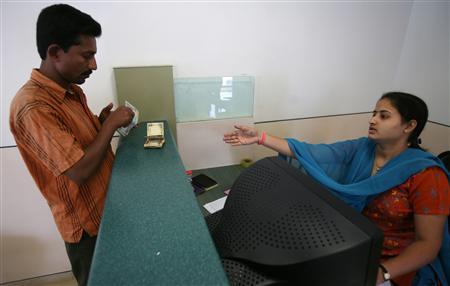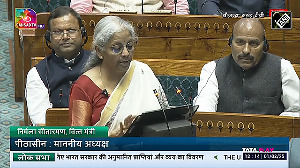 The recent recommendations of the Malegam Committee have drawn attention from all quarters.
The recent recommendations of the Malegam Committee have drawn attention from all quarters.Treating criticism and praise alike, the committee's chairman, Yezdi H Malegam, 77, a Board member of the Reserve Bank of India, said micro-finance institutions are an instrument to help mainly women work their way out of poverty and he raised some hard questions on how many of these institutions actually delivered for the cause.
The original intention of the sector should not be lost, he added.
In this interview with Abhijit Lele and Niladri Bhattacharya, Malegam candidly admits his perplexity at the criticism from unexpected quarters like the Microfinance Institutions Network, the representative body for MFIs. Excerpts:
Did you get the feeling that social consciousness was taking a back seat where MFIs were concerned when you made your recommendations?
No, our concern was to find a reasonable rate of return for the lender. We made some calculations on the basis of the actual average cost that is being incurred.
First, since the industry is growing at a very fast pace, MFIs incur a lot of development expenditure.
Now, this development expenditure should not be financed by current borrowers. There should be some ways through which MFIs bear that cost and recover it when they reach a certain size.
Second, MFIs have borrowed a fair amount from banks. The current industry figure is around Rs. 4,200 crore (Rs. 42 billion). However, those loans need to be serviced, which involves a cost.
Third, as MFIs grow, their total cost per loan will come down. So we believe that if we give the smaller MFIs a margin of 12 per cent and the bigger players a margin of 10 per cent, then a post-tax return of 15 per cent is easily possible.
If we look at it in another way, the average cost of borrowing for MFIs is less than 12 per cent. Let's take it as 12 per cent. If you add a 10 per cent margin for the larger MFIs, you get an interest rate of 22 per cent. If you add 12 per cent for smaller MFIs, then you charge 24 per cent.
There has been criticism from some quarters that your recommendations will restrict entry into the sector and will make life difficult for the smaller MFIs.
You cannot start a business and assume you will have profits from day one. When you are in the phase of building your business, you must be prepared to either accept lower profits or even losses while you are developing. You can't ask a current borrower to finance your growth. That has been the whole problem.
So do you think these recommendations will lead to consolidation in the sector?
The main reasons we need an optimum size is that costs fall when you achieve a certain size so you can afford to offer a lower interest rate. Also, 75 per cent of MFI funding is through the banking system, so if all MFIs remain small, then the risk to the banking system would become very large.
These are the main reasons we have recommended an optimum size. If this leads to some consolidation, that is unavoidable.
The question of what is optimal size is, again, a matter of judgement. And these are mere numbers. Whether the optimum net worth should be Rs. 10 crore (Rs. 100 million) or Rs. 15 crore (Rs. 150 million) is a matter of adjustment. We can always reduce it, if that is ultimately considered optimal. But you have to have some limit.
Is that healthy? What about equity investments, is it attractive enough especially for foreign investors?
Well, it all depends on whether you can raise capital on your own, then you don't need to consolidate. There is one other factor that should be taken into account.
If you go back to history, these MFIs were NGOs that were financed by foreign donors who gave donations or international agencies that gave loans at a low rate of interest.
That means there are people abroad who are willing to accept a small return for a social cause.
So, we have proposed the formation of social mutual funds that would invest in MFIs and that MFIs issue them preference shares.
Now, if you pay 12 per cent on preference shares, which constitute, say, 25 per cent of the total equity capital, then the return on the 75 per cent of equity shares can be more than 15 per cent in order to attain an average 15 per cent return on total equity.
What about private equity players from abroad?
There is no bias against PEs. But the point is, if PEs are willing to live with a 15 per cent return, then there is no problem. But if they want a 25 per cent return, then PEs are not desirable.
Similarly, if there is PE investment with an exit clause through an initial public offering, where in order to make the IPO successful MFIs try to make large profits, then who pays for it? Only the borrowers. So this is not acceptable.
What about the compensation package for employees, especially top and senior executives?
The margin cap includes everything. We are not suggesting anything on remuneration nor shareholder returns. Obviously, the larger the remuneration the lower the return for shareholders and vice-versa. It is then for the shareholders to decide on the issue. We cannot mandate on such things.
What is the rationale for recommending a separate category, NBFC-MFIs, for supervision and regulation?
The objective behind regulating non-banking finance companies was basically to protect depositors and avoid systemic risk. In the case of the MFIs, the objective is to protect the borrowers. So you have to create a separate category.
Once this is done, regulations will have to be framed to ensure that you achieve the objective. This is too important an area to be left to good intentions. You have to have strong regulations to ensure that intentions are translated into practice.
All MFIs have a vision statement that talks about a lot of things the institution will do for the poor. But the question is how many of them have actually done it?
Some of your recommendations have drawn severe criticism from the MFI sector.
I did find it very strange when people criticised their own recommendations. For example, on the provisioning norms, we have just accepted the MFIN's recommendations.
In fact, many of the aspects they recommended have been brought in the report.













 © 2025
© 2025